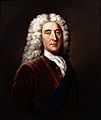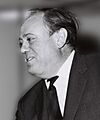Leader of the House of Lords facts for kids
Quick facts for kids United KingdomLeader of the House of Lords |
|
|---|---|
 |
|
| Office of the Leader of the House | |
| Nominator | Prime Minister |
| Appointer | The Monarch |
The Leader of the House of Lords is an important member of the UK government. This person is part of the Cabinet of the United Kingdom, which is a group of top ministers who make big decisions for the country. Their main job is to manage the government's plans and activities in the House of Lords.
The Leader of the House of Lords is also the main person for the ruling political party in the House of Lords. They help guide their party's work in the House. This role is always combined with another government job, often one that doesn't have many daily tasks, like the Lord President of the Council or Lord Privy Seal.
Even though the Leader is part of the government, they also have duties to the entire House of Lords. Unlike the House of Commons, where the Speaker controls debates, members of the Lords manage their own discussions. The Leader helps by reminding everyone of the rules and making sure things run smoothly. They often give advice on how things should be done.
Before 2006, the Leader of the House also made decisions about urgent questions and special legal rules. These jobs are now handled by the Lord Speaker, who is like the Speaker of the House of Lords.
Contents
History of the Leader's Role
The title "Leader of the House of Lords" started being used formally after the year 1800. It described the person in the House of Lords who was in charge of the government's work. However, a similar role might have existed as early as 1689.
This role grew in the early 1700s, at the same time as the job of Prime Minister and the way the Cabinet works. After big changes in Britain, like the Glorious Revolution, the government needed someone to guide new laws through Parliament. This person made sure the government's plans became law.
One of the first people to take on parts of this role was the Earl of Sunderland around 1717. He helped organize government matters in the House of Lords. Early records show lists of important people invited to meetings before Parliament sessions, which suggests the role was becoming established.
For a long time, if the Prime Minister was a member of the House of Lords, they usually also held the position of Leader of the House of Lords. If the Prime Minister was in the House of Commons, the Leader of the Lords was often a top minister like the Foreign Secretary.
Since 1902, the Leader of the House of Lords has been a clear and separate job within the Cabinet. Since 1966, the person holding this role usually doesn't have a big department to run. They might have extra duties, like being "Minister for Science" or "Minister for Women." The first woman to be Leader of the Lords was Janet Young, Baroness Young in 1981. Some Leaders of the Lords had also been the Leader of the House of Commons before.
Family Connections in Leadership
It's interesting to see how some families have had members serve as Leader of the House of Lords over generations.
- The Marquess of Salisbury family has a strong history in this role. The 3rd Marquess served three times between 1885 and 1902. His son, the 4th Marquess, was Leader from 1925 to 1929. Then, the 5th Marquess held the position twice, from 1942 to 1945 and from 1951 to 1957. Later, his grandson, the 7th Marquess, was Leader from 1994 to 1997.
- The Hogg family also had two members serve as Leader. Douglas Hogg, 1st Viscount Hailsham was Leader from 1931 to 1935. His son, Quintin Hogg, 2nd Viscount Hailsham, held the role from 1960 to 1963.
What the Leader Does
The Leader of the House of Lords has several key jobs:
- Managing Government Laws: They guide the government's new laws through the House of Lords. They help make sure these laws are passed.
- Leading the House: They help run the daily business in the House of Lords. This includes being a key member of committees that deal with rules and how the House is managed.
- House of Lords Issues: They handle matters related to the House of Lords itself and how it is governed.
- Speaking for the Government: They speak in the House of Lords on behalf of the government. This includes repeating important announcements made by the Prime Minister in the House of Commons.
- Ceremonial Duties: If they also hold the title of Lord Keeper of the Privy Seal, they perform special traditional duties.
See also
- House of Lords
- Leader of the House of Commons
Images for kids














































































